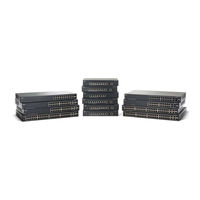Cisco Small Business 300 Series Manuals
Manuals and User Guides for Cisco Small Business 300 Series. We have 1 Cisco Small Business 300 Series manual available for free PDF download: Administration Manual
Cisco Small Business 300 Series Administration Manual (483 pages)
Managed Switch Release 1.3
Table of Contents
-
-
-
System Files51
-
Active Image58
-
-
-
SNTP Modes91
-
-
LLDP and CDP111
-
Configuring LLDP112
-
LLDP Overview113
-
LLDP Overloading130
-
-
Configuring CDP132
-
-
-
Overview162
-
Smartport Types163
-
Smartport Macros166
-
Auto Smartport169
-
Error Handling172
-
-
-
Vlans201
-
Creating Vlans206
-
GVRP Settings211
-
VLAN Groups212
-
Voice VLAN215
-
-
-
STP Flavors235
-
-
-
MLD Snooping264
-
-
Overview271
-
-
Ipv4 Interface273
-
Ipv4 Routes277
-
Arp278
-
ARP Proxy279
-
-
Dhcpv4 Snooping280
-
Dhcpv4 Relay281
-
Option 82281
-
-
-
DHCP Server293
-
DHCP Options293
-
-
Dhcpv4 Server296
-
Network Pool296
-
Static Hosts298
-
Address Binding300
-
-
-
-
Ipv6 Interface302
-
Ipv6 Tunnel305
-
Dhcpv6 Relay313
-
Domain Name314
-
DNS Settings315
-
Search List316
-
Host Mapping317
-
-
-
-
Defining Users320
-
SSL Server338
-
-
-
SYN Protection361
-
SYN Filtering363
-
ICMP Filtering365
-
IP Source Guard366
-
-
-
ARP Defaults372
-
-
-
-
Introduction377
-
SSD Management378
-
SSD Properties383
-
Passphrase384
-
Local Passphrase384
-
Read Mode386
-
Configuring SSD392
-
SSD Properties392
-
SSD Rules393
-
-
-
-
-
Passwords398
-
Import Keys399
-
-
Before You Begin402
-
Common Tasks402
-
-
Overview407
-
Common Tasks408
-
-
-
-
Qos Modes430
-
Qos Workflow431
-
-
Qos Basic Mode444
-
-
Chapter 23: SNMP
463-
-
Snmpv1 and V2464
-
Snmpv3464
-
SNMP Workflow464
-
-
Model Oids466
-
Supported Mibs466
-
-
SNMP Engine ID467
-
Advertisement
